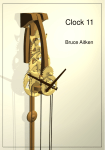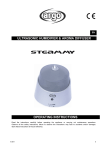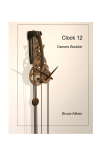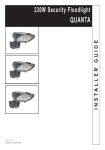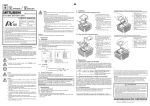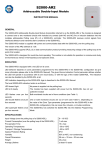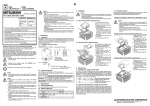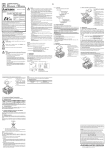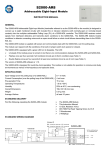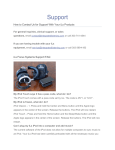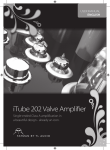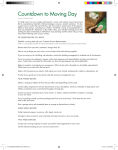Download Series 10 Instruction Manual
Transcript
Clock 10 Bruce Aitken This user manual accompanies one of the ‘Clock 10’ series of clocks designed and made by Bruce Aitken. Written, published, printed and bound by Bruce Aitken, Old Tram Depot Studio, 25 Rutland Street, Matlock DE4 3GN. 01629 580622 [email protected] http//www.bruceaitken-clockmaker.co.uk Copyright © Bruce Aitken 2009 All rights reserved. No part of this booklet my be reproduced in any form or by any electronic or mechanical means including information storage and retrieval systems without written permission from the publisher. Before starting to unpack and install the clock, please gather the following items: • An old towel, blanket or similar • A pillow • A crosshead screwdriver • A pair of scissors or wirecutters contents Opening the crate Pages 4 - 5 Fitting the Wall Bracket Pages 6 - 7 Removing and Handling the Clock Pages 8 - 9 Fitting the Clock Pages 10 - 11 Fitting the weight cord Pages 12 - 13 Hanging The Weights Pages 14 - 15 Adjusting The Clock Pages 16 - 17 Timekeeping Page 18 Running Page 19 Dismantling the and Re-packing the Clock Page 20 Naming of Parts Pages 21 - 22 Opening the crate The crate that contains your clock is a singularly scruffy bit of woodwork. Please protect the surface you intend to place the crate upon by spreading an old towel first. To open the crate a small crosshead screwdriver is required. The screws that hold the crate closed are numbered, they should be removed in order. First, remove the four screws securing the lid - before removing the lid note that it will only fit one way round (tell-tale marks near screw 1 will help when you come to replace the lid). Locate and set aside the bag containing the drive cord. Next, remove the two screws indicated to allow one end of the crate to fold down (the end that holds the Wall Bracket) Now remove the single screw (indicated) and fold down the side of the crate. Now remove the final screw - be aware that this one screw holds the last two sides of the crate in place, and these both house heavy parts of the clock. They will come to no harm if they do fall, but it is preferable to support them and let them down gently. The Opened Crate and its Contents Clock Movement Main Driving Weight Upper Pendulum Counterweight Lower Pendulum Wall Bracket Uscrew and remove the Wall Bracket, the Upper Pendulum and the Lower Pendulum from the opened crate. You’ll need use the screwdriver to remove the individual parts from the crate - be sure to screw any detachable parts of packaging back in place in the crate before they are lost. The empty crate can either be stored flat or rebuilt. Fitting the Wall Bracket Two screws set into the wall 100mm apart hold the clock in place. The clock was designed to be viewed with the bottom screw roughly around eye level. The Wall Bracket is drilled to accept 4mm diameter screws (8 gauge) - choose suitably sized wallplugs or heavy duty cavity wall fixings for your wall. Effort spent ensuring the bracket is mounted vertically will be well rewarded - the clock will run perfectly with a wonky bracket, but the bracket will be, well, wonky. Fit the upper pendulum as shown. Ensure the pendulum mounting block is properly located on the mounting lugs. Screw in place with the screw (supplied). The lower pendulum is quite heavy, and it is quite easy to drop it the first time you try to put it in place. It is a good idea to place a pillow on the floor just in case. Removing and Handling the Clock The main body of the clock is robust, but does require special care. In it’s crate the clock is mounted on a brass rod, and held in place by a plastic cable-tie. This needs to be cut to remove the clock. (a new cable-tie will be needed when the clock is re-packed). Once the cable-tie is cut, lift the clock mechanism holding the top of the clock frame as arrowed - it’s a snug fit and needs to be eased upwards gently. The clock is an awkward object to handle - it is best held by the top plate or by the pulley yoke at the bottom of the clock, as arrowed. Be aware that the most fragile part of the clock is vulnerable to damage at this point - this is the crutch, which is the little tab protruding from the back of the clock frame. To avoid damage to this part don't lay the clock down on its back. Should you need to put the clock down place it upside down on its top plate where it will sit precariously balanced. It will also survive being placed on the pillow we used earlier. Watch that crutch, though. Fitting the Clock Mounting the clock on the wall bracket is straightforward. Rotate the brass mounting bar (found in the wall bracket) so it points slightly upwards, and hold the clock so that the rear mounting hole lines up with the mounting bar. Locate the bar in the hole and gently slide the clock home. Take care to ensure that the bracket arms pass below the top plate and above the escapement anchor. Gently rotate the clock into place. The crutch needs to locate correctly with its slot in the pendulum rod - the end of the crutch is tapered to allow this to happen easily; it is wise however to watch closely and take this part slowly. When the clock is hanging vertically with the crutch engaged, give the top of the frame one final push toward the wall to make sure it is fully in place. Fitting the weight cord 1 First, hold the two wooden terminals and let the cord hang - make sure there are no knots, and identify the shorter of the terminals. Slide the shorter terminal into the hole on the left hand side of the pulley yoke. Let the cord hang in a loop as you hold the other terminal. 2 Second, from the right side, pass this terminal through the clock frame, pulling the cord after it. The cord should run on the small pulley and on the groove in the drive arbour, which will rotate noisily as the cord is pulled. 3 Now, from the left again, loop the cord around the two pulley wheels as shown. Pull enough cord through so that there is a loop hanging at about the height of the pendulum bob. 4 Back to the right hand side, pop the terminal into its hole, and arrange the cord into its groove. The two loops of cord can be persuaded to hang with no kinks or twists by rotating the terminals in their holes one way or the other. Do this until the cord hangs neatly. Hanging The Weights The weight cord should be hanging as shown in the first illustration. Before hanging the weights, double check to ensure that the cord sits in its groove in the drive arbour. Slip a thumb into the smaller of the two loops and apply a little downward pressure as you hang the large drive weight in the remaining loop. Now hang the counterweight in the smaller loop. The clock is wound by placing a thumb in the counterweight hole and pulling downwards, lifting the drive weight. A good deal of force is required to raise the weight; expect the ratchet mechanism to make a moderately loud noise during winding. For the clock to run correctly, two separate adjustments need to be made: Firstly, It needs to hang vertically with respect to the wall. Secondly, It needs to run “in beat”. Both adjustments are made using the two allen keys provided, which fit into the grub-screws (in the holes furthest forward in the clocks top plate). Hanging the Clock Vertically This adjustment allows the clock to be installed on a wall that is not quite vertical. You can tell at a glance if you need to perform this stage. The pendulum is already hanging vertically from the bracket - if the rear frame member is hanging parallel to the pendulum you may skip the rest of this page. If both allen keys are rotated in the same direction at the same time, the mechanism will slowly rock towards or away from the wall. Adjust the allen keys together until the mechanism hangs vertically (as viewed from the side). Adjusting the Beat Leave the allen keys in place to make the second adjustment. If these are now rotated in opposite directions (as shown below), the clock mechanism is made to rock from one side to the other. First make a quick visual check to see that the front frame member is more or less vertical, using the allen keys to correct as needed (turning both keys by the same amount but in opposite directions). Start the clock by gently swinging the pendulum. Watch the escapement carefully, in particular observe the how far the anchor pallets swing out away from the teeth - this maximum should be the same on both sides. The illustration shows which direction to turn the keys to bring the clock into balance. Make small adjustments, remembering to turn both keys by the same amount and in opposite directions. The clock should now be running “in beat” and should produce a balanced “tick - tock - tick - tock” sound (rather than “tick … tock tick… tock tick”. This is a precise adjustment - expect to spend a little time making sure that the swing of the anchor in and out of the escape wheel is the same on both sides. Timekeeping To adjust the clock hands • First grasp the adjuster and press it towards the clock (this disengages the hands from the main movement). • Rotate the adjuster clockwise while continuing to press - the hands follow. • Set the time. The clock is capable of keeping time accurately. If the clock is running slow rotate the bobnut as shown in the left hand illustration, follow the right hand illustration if it is running fast. If the Clock Runs Slow daily difference adjustment (in minutes) (bobnut turns) 1 2 5 2 4 10 weekly difference adjustment (in minutes) (bobnut turns) 1 0.3 2 5 0.6 1.5 If the Clock Runs Fast Running The clock is designed to be wound at roughly the same time each day - it will run for 30 hours on one complete wind. Apply a firm even downwards force, but try not to rush the winding - aim to have wound the clock by the time you have counted to five. Allow the drive weight to meet the bottom of the clock frame gently as you complete the winding. If the clock is allowed to run down it will stop, the counterweight held neatly by the bottom of the frame. Wind the clock again, and gently restart. The normal running of the clock can be disrupted by a few circumstances. Should it become reluctant to work try these procedures: • Restart the clock - if it runs, check that it is running ‘in beat’ (the escapement anchor swings away from the escape wheel by the same amount on each side). This adjustment can drift over time - re-adjust with the allen keys if needed. • If the clock won’t start (the escape wheel doesn’t rotate when the pendulum is swung) several steps can be taken - first take the escape wheel and gently jiggle it in and out, and repeat for the intermediate wheel. Now rotate the clock hands a full 12 hours before setting the time and re-starting the clock. Normally these methods will enable the clock to return to its normal stable running. If it continues to require frequent re-starts, however, it may need to be returned to the workshop. Please do not hesitate to get in touch if you experience any difficulty with the clock. Dismantling the and Re-packing the Clock At some time it will be necessary to dismantle the clock for storage, moving house or returning to the workshop for maintenance. You will need the crate, the old towel, pillow and crosshead screwdriver used when the clock was first unpacked, plus a new plastic cable-tie and a pair of pliers. • • • • • • Wind the clock so that the main weight is close to its highest position, as shown. Set the time to read 12:00 (1). Stop the clock by gently arresting the pendulum bob(2). Remove the counterweight (3) followed by the drive weight (4). Remove the cord terminals from the frame (5). Gently pull the cord out in the direction shown (6). If the clock is being returned to the workshop, our telephone discussion will have clarified which items need to be included - probably just the clock mechanism. If this is the case, the weights will need to be stored safely outside the crate. If the entire clock is being packed, fix the weights in their places now, wind up the cord and bag it. Now remove the clock mechanism from the wall bracket. This is the reverse of the process detailed on pages 10 - 11. Rest it on the pillow as required. Carefully lower the clock mechanism onto the vertical brass rod in the crate, taking care to locate the rod properly with the clocks mounting hole and ensuring that the crutch sits within its protective slot. Slide the cable-tie through its hole in the crate (just next to the crutch slot), feed it back through the clock frame and tighten with the pliers it so it holds the frame back securely. If the clock mechanism alone is being returned, the crate sides can now be re-assembled by reversing the process shown on pages 4 - 5. The wall bracket and pendulum can remain in place on your wall. If the entire clock is to be packed, removing the pendulum and bracket is simply a matter of reversing pages 6 - 7. Remember to be careful when removing the pendulum joining peg as the lower pendulum is heavy and can fall - the pillow placed underneath is a good precaution. The pendulum mounting block is a tight fit and can be difficult to remove. There is a slight groove on at the rear of its top surface for a fingernail to pull it, please don’t exert force on the upper pendulum as the pivot can be damaged. If the entire clock is being packed, please ensure that the individual parts are well secured in their places. Place the capping piece in the bag alongside the cord, the dusting brush and the allen keys, and tape (staple, ideally) this bag inside the crate lid. Although the clock can withstand wide temperature variations, storage at a cool room temperature is preferred. Please ensure that it is stored in a dry place, especially for long term storage. Naming of Parts Wall Bracket Clock Mechanism Pendulum Drive Weight Counterweight Naming of Parts Bracket Cheek Bracket Back Upper Pendulum Frame Back Member Pendulum Joiner Lower Pendulum Bracket Top Plate Anchor Mount Frame Front Member Going Train Wheels Clock Hands Motion Work Wheels Frame Yoke























